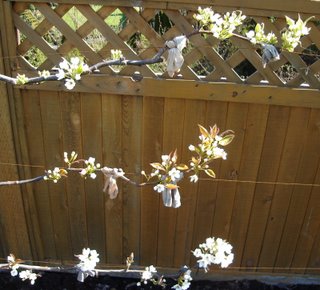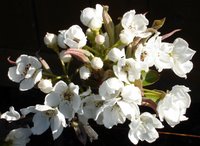
 Today the espalier asian pear tree is in full blossom (photos right), and looks very happy in his new location. The same with the espalier apple tree, which is just starting to blossom (photo left). The key to my success was moving the trees while they were still dormant, while the soil was very moist, and the weather was cool and raining regularly.
Today the espalier asian pear tree is in full blossom (photos right), and looks very happy in his new location. The same with the espalier apple tree, which is just starting to blossom (photo left). The key to my success was moving the trees while they were still dormant, while the soil was very moist, and the weather was cool and raining regularly.
Most new gardeners I speak with, are quite anxious not to make a "mistake" in their garden. There is not too much which they can do wrong. In contrast to human inventions, which are subject to constant failure and breakdown, the plant world is very resilient and can easily survive a wide variety of conditions (soil, sun/shade, watering/drainage), although to achieve the best "look", there is of course an optimal range of conditions. Over time, a gardener learns to anticipate plant preferences and also"read" the responses from the plants, and react to move plants or correct situations which are not favourable. Seeking advice from more experience gardeners is always a great way to learn, and gardeners are generally pretty friendly folk, and very happy to share their knowledge and passion.
The following tips or guidelines are ones which I've learned over the years, and will help to make the gardening experience a more successful and rewarding one.
Plant on Shady Days, Weed on Sunny Days - Moving or planting in a new plant on an overcast day will reduce the shock to the plant. Timing it so that it will rain for the next couple days after the move is optimal. So use the sunny and hot days to pull weeds instead.
Always Water after Planting - Likewise, watering after planting helps to gently settle and compact the soil, and provide the roots with much-needed moisture to reduce the shock.
Water the Soil, not the Foliage - Very few plants benefit from water on their foliage, and it may contribute to burn (if the sun hits it) or mildew or other diseases. The exception is with some insect infestations, such as aphids or spider mites, where a very vigorous ("jet" setting) spraying with water may be an effective pesticide-free method of insect control.
Water in the Shade or in the Cool Part of the Day - This is closer to way plants are watered (rained on) in nature, with the cool water soaking into cool soil. Early morning is ideal, but not always practical. As a reasonable compromise, I often water in the early evening, once the area is in complete shade.
Plant According to Sun & Soil Preferences - Use the plant tag as a rough guideline for where to plant, whether in full sun, partial shade, or deep shade, and also for basic soil (wet / dry) conditions. Or observe where the plant is growing successfully in neighbour's yards. Generally, plants with soft leaves (think lettuce) need good moisture and some shade or will tend to wilt. Plants with silvery foliage (think lavenders), or tough narrow leaves (think grasses or yucca) can withstand drought (sunny/dry) conditions well.
Plant at the Same Depth - When moving a plant, plant it in at the same level as it was previously in the garden or pot. Most plants don't want to be dug in deeper, or higher. If starting from seed, then the plant will establish its own preferred depth.
Picking Flowers is Okay - The flower part of the plant takes lots of energy to support. It is only of reproductive benefit, and not feeding the plant in any way. There is no danger (unless you are waiting for fruit or seeds) to removing flowers at any time, to enjoy indoors or share with friends. Of course, most flowers will persist much longer outdoors, but don't be afraid to pick and enjoy.
Removing Spent Flowers is Great - Unless you are waiting for fruit or seeds, removing the flowers as soon as they are done is good practice. It keeps the garden tidy (reducing places for slugs and other undesirables to hide), and many plants respond by either continuously sending out more flowers, or sending out a second flush of flowers.
Prune for Damaged or Unbalanced Growth - Pruning is a daunting task for a new gardener, but there is never any danger of pruning out or pinching off diseased or damaged branches or leaves, and it is usually beneficial to the plant. Don't compost any of this material, discard it, to reduce the chance of spreading disease or harbouring pests. If you want to know more about pruning, I strongly recommend the book Cass Turnbull's Guide to Pruning (on Amazon.ca)


1 comment:
I also garden in Burnaby, (south slope by Royal Oak) and don't have any issues with those particular weeds but Morning Glory is the bane of my existence.
Post a Comment